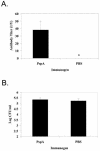Limited role of antibody in clearance of Streptococcus pneumoniae in a murine model of colonization
- PMID: 15385481
- PMCID: PMC517579
- DOI: 10.1128/IAI.72.10.5807-5813.2004
Limited role of antibody in clearance of Streptococcus pneumoniae in a murine model of colonization
Abstract
Colonization is the first step in the interaction between Streptococcus pneumoniae and its human host. To better understand the mechanisms contributing to natural carriage, a mouse model of pneumococcal colonization was developed with a clinical isolate of S. pneumoniae previously characterized in experimental colonization of humans. Similar to carriage events in humans, colonization of mice was self-limited and there was no evidence of lower respiratory tract or invasive disease. Carriage induced a serum antibody response to whole pneumococci that was associated temporally with clearance of colonization in three inbred strains of mice. Individual mice, however, did not demonstrate a correlation between the density of colonization and amounts of serum or of mucosal antibodies, including antibodies of different isotypes and antigenic specificities. The role of antibody in the clearance of carriage was then examined in mice with genetic defects in humoral immunity. xid mice, which have deficient responses to polysaccharide antigens, cleared colonization at the same rate as the parent strain. Finally, we showed that microMT mice, which lack mature B cells and fail to produce antibody, were unaffected in the density or duration of colonization. These results demonstrate that antibody is not required for clearance of pneumococcal colonization in mice.
Figures





Similar articles
-
Elicitation of mucosal immunity by proteins of Streptococcus pneumoniae.Adv Otorhinolaryngol. 2011;72:25-7. doi: 10.1159/000324589. Epub 2011 Aug 18. Adv Otorhinolaryngol. 2011. PMID: 21865682
-
Impaired innate and adaptive immunity to Streptococcus pneumoniae and its effect on colonization in an infant mouse model.Infect Immun. 2009 Apr;77(4):1613-22. doi: 10.1128/IAI.00871-08. Epub 2009 Jan 21. Infect Immun. 2009. PMID: 19168741 Free PMC article.
-
Compound 48/80 acts as a potent mucosal adjuvant for vaccination against Streptococcus pneumoniae infection in young mice.Vaccine. 2015 Feb 18;33(8):1008-16. doi: 10.1016/j.vaccine.2015.01.013. Epub 2015 Jan 14. Vaccine. 2015. PMID: 25595867
-
Mechanisms of Naturally Acquired Immunity to Streptococcus pneumoniae.Front Immunol. 2019 Mar 1;10:358. doi: 10.3389/fimmu.2019.00358. eCollection 2019. Front Immunol. 2019. PMID: 30881363 Free PMC article. Review.
-
Understanding host immune responses to pneumococcal proteins in the upper respiratory tract to develop serotype-independent pneumococcal vaccines.Expert Rev Vaccines. 2020 Oct;19(10):959-972. doi: 10.1080/14760584.2020.1843433. Epub 2020 Nov 8. Expert Rev Vaccines. 2020. PMID: 33107359 Review.
Cited by
-
Immunization with recombinant Streptococcus pneumoniae neuraminidase NanA protects chinchillas against nasopharyngeal colonization.Infect Immun. 2005 Nov;73(11):7775-8. doi: 10.1128/IAI.73.11.7775-7778.2005. Infect Immun. 2005. PMID: 16239584 Free PMC article.
-
Characterization of protective mucosal and systemic immune responses elicited by pneumococcal surface protein PspA and PspC nasal vaccines against a respiratory pneumococcal challenge in mice.Clin Vaccine Immunol. 2009 May;16(5):636-45. doi: 10.1128/CVI.00395-08. Epub 2009 Mar 11. Clin Vaccine Immunol. 2009. PMID: 19279169 Free PMC article.
-
Coinfection with Streptococcus pneumoniae modulates the B cell response to influenza virus.J Virol. 2014 Oct;88(20):11995-2005. doi: 10.1128/JVI.01833-14. Epub 2014 Aug 6. J Virol. 2014. PMID: 25100838 Free PMC article.
-
Capsule enhances pneumococcal colonization by limiting mucus-mediated clearance.Infect Immun. 2007 Jan;75(1):83-90. doi: 10.1128/IAI.01475-06. Epub 2006 Nov 6. Infect Immun. 2007. PMID: 17088346 Free PMC article.
-
Genomic and panproteomic analysis of the development of infant immune responses to antigenically-diverse pneumococci.Nat Commun. 2024 Jan 8;15(1):355. doi: 10.1038/s41467-023-44584-2. Nat Commun. 2024. PMID: 38191887 Free PMC article.
References
-
- Austrian, R. 1986. Some aspects of the pneumococcal carrier state. J. Antimicrob. Chemother. 18:35-45. - PubMed
-
- Blunt, T., N. Finnie, G. Taccioli, G. Smith, J. Demengeot, T. Gottlieb, R. Mizuta, A. Varghese, F. Alt, P. Jeggo, and S. Jackson. 1995. Defective DNA-dependent protein kinase activity is linked to V(D)J recombination and DNA repair defects associated with the murine scid mutation. Cell 80:813-823. - PubMed
-
- Bogaert, D., R. de Groot, and P. Hermans. 2004. Streptococcus pneumoniae colonisation: the key to pneumococcal disease. Lancet Infect. Dis. 4:144-154. - PubMed
Publication types
MeSH terms
Substances
Grants and funding
LinkOut - more resources
Full Text Sources
Other Literature Sources
Medical
Molecular Biology Databases

